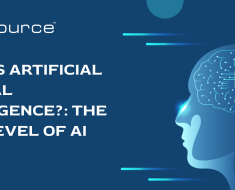
The retail industry stands at the doorway of a new era driven by artificial intelligence.
In the coming months and years, generative AI promises to reshape retail, empowering retailers with innovative solutions and transforming the customer experience.
With new tools and techniques like large language models, image generators, and predictive analytics, forward-thinking retailers have an unprecedented opportunity to evolve their businesses.
Leading technology providers are racing to put these nascent AI capabilities into retailers’ hands through intuitive cloud platforms and ready-to-deploy solutions.
Early adopters who embrace AI with vision and care stand primed to revolutionise customer experiences, unlock employee productivity, and propel dramatic growth; However, those who fail to invest in AI’s potential risk obsolescence in an increasingly competitive landscape.
The stakes could not be higher as generative AI emerges from buzzword status into a transformative force poised to upend retail. With consumer habits and expectations changing rapidly, retailers must keep pace by strategically leveraging AI.
The coming months will separate retail pioneers from digital dinosaurs based on who most creatively capitalises on AI. By starting small but thinking big, retailers can steadily build AI into the fabric of their operations in ways that engage customers and empower employees. The future of retail will belong to those who embrace AI not as a trend but as an enduring strategy.
The Promise and Potential of Generative AI
Generative AI refers to machine learning models that can generate new content and output based on patterns in data. Unlike traditional AI focused on analysis, generative models can produce images, text, audio, video, and more.
Today’s most buzzed-about generative AI utilises large language models (LLMs) trained on vast datasets. LLMs like Google’s LaMDA and Microsoft’s GPT-3 demonstrate strong language proficiency and can engage in remarkably human-like dialogue.
Over the past year, generative AI has exploded in capability and accessibility. Where it was once an emerging novelty, industries now recognise it as a transformative force.
A survey by Nvidia found that 98% of retailers plan to invest in generative AI within 18 months. With more affordable cloud offerings, pre-trained models, and intuitive tools, companies of all sizes can put generative AI to work.
So, how exactly can generative AI benefit retailers?
The potential use cases span a retailer’s business:
- Personalised marketing: Generate tailored emails, promotions, and customer product recommendations based on their data and preferences.
- Automated content creation: Produce product descriptions, ads, social media posts, and other content to engage customers and improve SEO.
- Chatbots: Deploy virtual assistants with natural conversations with shoppers to provide helpful recommendations and product options.
- New product designs: Generate variations on existing or wholly new concepts based on consumer trends and historical sales data.
- Demand forecasting: Predict future demand more accurately by analysing historical sales, seasonal trends, and other factors.
- Inventory and supply chain optimisation: Streamline inventory management and logistics based on demand forecasts.
As seen above, these applications of generative AI in retail aim to provide hyper-personalised experiences for shoppers while optimising operations. With solutions now available, early adoption in 2024 will be essential for retailers looking to stay ahead.
Google Cloud Unveils New Generative AI Tools for Retailers
Recognising this enormous potential, Google Cloud unveiled several new AI and generative AI solutions for retailers at the National Retail Federation’s “Big Show” conference. Google Cloud is making it easy for retailers to get started with impactful applications of generative AI.
One innovation is a conversational commerce solution that allows retailers to deploy personalised, generative AI-powered chatbots on their sites. These virtual agents can naturally dialogue with customers to provide thoughtful product recommendations tailored to shoppers’ needs and preferences. Retailers can build the bots using Google Cloud’s Vertex AI platform and have them up and running in just weeks.
Google also introduced a new large language model (LLM) capability in its Vertex AI Search product explicitly designed for retail. Retailers can customise the LLM by “training” it on their unique product catalogue and customer search patterns. This customisation powers more relevant search results, product discovery, and recommendations for shoppers. For example, a home improvement retailer could tune the LLM to understand English and Spanish queries for their products.
On the operations side, Google unveiled AI-powered solutions to help retailers modernise customer service and streamline cumbersome product catalogue management.
The customer service solution integrates a retailer’s CRM system for AI-assisted agents to provide personalised recommendations and schedule appointments. It also uses AI to summarise customer conversations and suggest relevant responses to human agents.
Meanwhile, the catalogue solution uses AI to generate and enrich product information such as descriptions, titles, and metadata based on a retailer’s existing catalogue data. The use of AI in this process saves significant manual effort.
Microsoft Partners with Walmart on Retail AI Innovations
Not to be outdone, Microsoft has been collaborating with retail giant Walmart on AI-driven innovations for its e-commerce business and physical stores. One primary focus has been developing generative AI search for Walmart’s website and mobile app.
It uses Azure OpenAI capabilities and Walmart’s retail data to enable more natural, conversational product searches. A parent planning a kid’s birthday party could ask the AI assistant for help rather than searching for individual items.
Microsoft and Walmart have also created new AI tools for Walmart associates. Last year, Walmart introduced an internally built AI agent called My Assistant to help employees summarise documents and generate content.
In 2024, they are expanding My Assistant to associates in 11 countries. Walmart is also piloting computer vision AI at Sam’s Club locations to streamline exit checks of customers’ paid items.
The Benefits and Considerations of AI Adoption
As Google Cloud and Microsoft demonstrate, major technology providers are making it easier than ever for retailers to experiment with AI-powered innovations. But what results are retailers seeing from AI adoption?
According to Nvidia’s survey, early adopters report increased revenues, lower costs, and higher customer retention. According to McKinsey research, AI personalisation alone can lift sales by 15-20%.
However, retailers must approach AI thoughtfully. Most companies still invest under $5 million as they weigh benefits vs. risks. AI requires upfront costs for technology, tools, and talent. Retailers need an execution roadmap aligned with business goals.
Change management is also critical, as AI will affect processes and jobs. Though AI shows immense promise, retailers must ensure they use it to augment human abilities rather than replace them truly.
Conclusion
With thoughtful strategies, retailers can harness AI as a true competitive advantage. As AI’s capabilities grow exponentially, the coming years will separate retailers who successfully leverage AI from those who fail to adapt.
By embracing AI’s potential now, retailers can drive tangible improvements in customer experience, employee productivity, and the bottom line.
The technology to start this transformation already exists. The question for retailers is: How quickly will you adopt it?
Read here, Impact of AI on Employment and Job Availabilities.
Researched by Adejoke Toye





